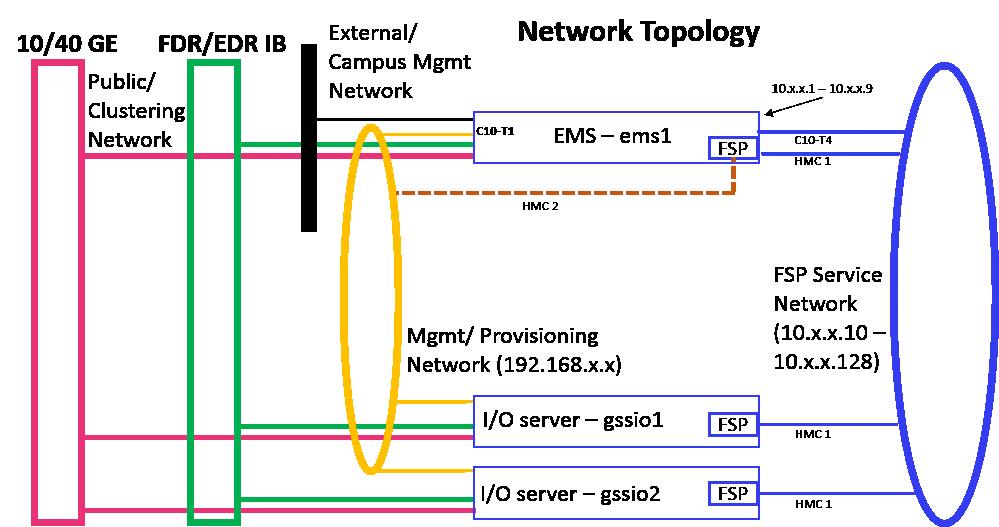ESS networking considerations
This topic describes the networking requirements for installing ESS.
Networking requirements
- Service network
This network connects the flexible service processor (FSP) on the management server and I/O server nodes (with or without the HMC, depending on the platform) as shown in blue in Figure 1 and 2 on the following pages.
- Management and provisioning network
This network connects the management server to the I/O server nodes (and HMCs, if available) as shown in yellow in in Figure 1 and 2 on the following pages. The management server runs DHCP on the management and provisioning network. If a management server is not included in the solution order, a customer-supplied management server is used.
- Clustering network
This high-speed network is used for clustering and client node access. It can be a 10 Gigabit Ethernet (GbE), 25 GbE, 40 GbE, 100 GbE, or InfiniBand network. It might not be included in the solution order.
- External and campus management network
This public network is used for external and campus management of the management server, the HMC (if available), or both.
- IBM Elastic Storage® Server networking with Mellanox adaptersMellanox ConnectX-2 adapter cards improve network performance by increasing available CPU bandwidth, which enhances performance in virtualized server environments. Mellanox ConnectX-2 adapter cards provide:
- Data Center Bridging (DCB)
- Fibre Channel over Ethernet (FCoE)
- SR-IOV
For information on using Mellanox adapter cards, see: http://www.mellanox.com/page/ethernet_cards_overview
Figure 1, Network Topology, is a high-level logical view of the management and provisioning network and the service network for an ESS building block (on PPC64BE).

Figure 2, Network Topology, is a high-level logical view of the management and provisioning network and the service network for an ESS building block (on PPC64LE).

The HMC, the management server, and the switches (1 GbE switches and high-speed switches) might not be included in a solution order in which an existing or customer-supplied HMC or management server is used. Perform any advance planning tasks that might be needed to access and use these solution components.
Customer networking considerations
Review the information about switches and switch firmware that were used to validate this ESS release. For information about available IBM® networking switches, see the IBM networking switches page on IBM Knowledge Center.
It is recommended that if two switches are used in a high availability (HA) configuration, both switches be at the same firmware level.- SSH to the switch.
- Issue the following commands.
For example:# en # show version
Example output:login as: admin Mellanox MLNX-OS Switch Management Using keyboard-interactive authentication. Password: Last login: Mon Mar 5 12:03:14 2018 from 9.3.17.119 Mellanox Switch io232 [master] > io232 [master] > en io232 [master] # show versionProduct name: MLNX-OS Product release: 3.4.3002 Build ID: #1-dev Build date: 2015-07-30 20:13:19 Target arch: x86_64 Target hw: x86_64 Built by: jenkins@fit74 Version summary: X86_64 3.4.3002 2015-07-30 20:13:19 x86_64 Product model: x86 Host ID: E41D2D52A040 System serial num: Defined in system VPD System UUID: 03000200-0400-0500-0006-000700080009
Infiniband with multiple fabric
verbsPorts
configuration statement during the cluster creation. Incorrect verbsPorts setting
might cause the outage of the IB network. It is advised to do the following to ensure that the
verbsPorts setting is accurate:- Use gssgennetworks to properly set up IB or Ethernet bonds on the ESS system.
- Create a cluster. During cluster creation, the
verbsPortssetting is applied and there is a probability that the IB network becomes unreachable, if multiple fabrics are set up during the cluster deployment. - Ensure that the GPFS daemon is running and then run the mmfsadm test verbs config | grep verbsPorts command.
# mmfsadm test verbs config | grep verbsPorts
mmfs verbsPorts: mlx5_0/1/4 mlx5_1/1/7mlx5_0, port 1 is connected to fabric 4 and the adapter
mlx5_1 port 1 is connected to fabric 7. Now, run the following command and ensure
that verbsPorts settings are correctly configured to the GPFS
cluster.# mmlsconfig | grep verbsPorts
verbsPorts mlx5_0/1 mlx5_1/1verbsPorts setting for each node or node class to take the subnet into
account.[root@gssio1 ~]# verbsPorts="$(echo $(mmfsadm test verbs config | \
grep verbsPorts | awk ’{ $1=""; $2=""; $3=""; print $0} ’))"
# echo $verbsPorts
mlx5_0/1/4 mlx5_1/1/7# mmchconfig verbsPorts="$verbsPorts" -N gssio1
mmchconfig: Command successfully completed
mmchconfig: Propagating the cluster configuration data to all
affected nodes. This is an asynchronous process.verbsPorts setting is changed, make sure that the new,
correct verbsPorts setting is listed in the output of the
mmlsconfig
command.# mmlsconfig | grep verbsPorts
verbsPorts mlx5_0/1/4 mlx5_1/1/7Switch information

| Type | IBM MTM | Melannox switch model | Description | Latest validated switch OS (June 2020) |
|---|---|---|---|---|
| IB - FDR | 8828-F36 8828-F37 |
SX6036 | 36-port FDR switch | mlnxOS 3.6.8012 |
| IB - EDR | 8828-E36 8828-E37 |
SB7700 | 36-port EDR switch (switchIB1) |
mlnxOS 3.9.0300 |
| IB - EDR | 8828-G36 8828-G37 |
SB7800 | 36-port EDR switch (switchIB2) |
mlnxOS 3.9.0300 |
| ETH - 1GbE | 8831-S52 | Edgecore AS4610 | 48-port 1G + 4-port 10G SFP+ | cumulus-3.7.12a |
| ETH - 40GbE | 8831-NF2 | SX1710 | 36-port 40G switch | Onyx 3.6.8012 |
| ETH - 10GbE | 8831-S48 | SX1410 | 48-port 10G + 12-port 40G | Onyx 3.6.8012 |
| ETH - 100GbE | 8831-00M | SN2700 | 32-port 40G/100G | Onyx 3.9.0300 |
| ETH - 10/25/40/100 | 8831-25M | SN2410 | 48-port 10G/25G + 8-port 40G/100G | Onyx 3.9.0300 |
